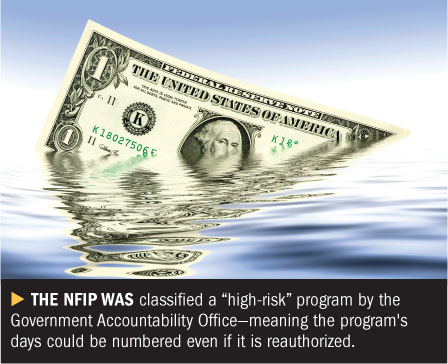The debate over raising the debt limit may indicate that the end is approaching for government support of every program that has a constituency.
Supposedly, the date when the limit will be reached is Friday, May 6.
 While that may be stretched a few weeks, it is wise that those involved in the insurance industry consider what programs might be endangered by the need to be more selective in what the government subsidizes going forward.
While that may be stretched a few weeks, it is wise that those involved in the insurance industry consider what programs might be endangered by the need to be more selective in what the government subsidizes going forward.
One of the first programs that comes to mind is the National Flood Insurance Program, already $17.5 billion in the red.
While the NFIP has a strong constituency within the insurance industry, and especially from subsidized customers, the bell may be tolling for the program in its present form.
The U.S. Deficit Commission highlighted the funds the U.S. expends on dealing with catastrophes in its report last December, and the Government Accountability Office was even more specific in February when it classified the NFIP as one of 30 “high-risk” programs.
The report, released Feb. 16, said these high-risk programs are a problem due to “greater vulnerabilities to fraud, waste, abuse and mismanagement or the need for transformation to address economy, efficiency or effectiveness challenges.”
The GAO report says the NFIP is not actuarially sound and that NFIP management cannot take some of the steps that private insurers can to manage risks.
For example, the GAO says the NFIP is not structured to build a capital surplus, is likely unable to purchase reinsurance to cover catastrophic losses, cannot reject high-risk applicants and is subject to statutory limits on rate increases.
A new report released by the Property Casualty Insurers Association of America (PCI) casts further doubt on the program. The research paper says the current rates for NFIP policyholders are about a third of the true risk cost in many parts of the country.
The PCI study concludes that, overall, the federal government is providing flood insurance at roughly one-half the true risk cost for NFIP policies. In higher-risk areas, the explicit subsidy is even greater, resulting in a true risk cost that is more than three times higher than NFIP rates, the study finds.
“These large disparities between NFIP and market-risk rates are the result of the non-actuarial approach required of the NFIP, in addition to the fact that program rates do not reflect lost tax revenue, capital costs, nor the costs of a catastrophe backstop (with Treasury backstopping the risk exposure for very large, less frequent events),” the study finds.
The PCI study says that the private market underwrites about 128,000 to 187,000 flood-insurance policies, likely in low-risk areas and typically for excess coverage or as a part of larger high-value coverage.
“Not only are current NFIP rates far below what a private market would have required to attract capital, but there are inadequate data available for flood-risk modeling and numerous legal challenges,” the study says.
“Insurers would find it difficult to obtain adequate rates to attract capital or be able to prevent adverse selection by homeowners, since insurers' rates and coverages are subject to price controls and mandates in most states,” the study concludes.
Robert Gordon, PCI's senior vice president of policy development and research, said PCI released the report as a “benchmarking tool to help lawmakers as they discuss the Flood Insurance Reform Act of 2011,” legislation that recently passed a House Financial Services Committee subcommittee. The legislation would reauthorize the program for five years and undertakes a smattering of reforms.
But as Congress debates how much to raise the debt limit and starts work on a federal budget for 2012, it will be confronting the reality of a U.S. “AAA” credit rating at risk and a declining dollar that will raise the cost of imports the U.S. depends on.
The NFIP may, indeed, be reauthorized for five years before the current reauthorization expires Sept. 30. But the reality is that this reauthorization may be the last one in its present form.
Want to continue reading?
Become a Free PropertyCasualty360 Digital Reader
Your access to unlimited PropertyCasualty360 content isn’t changing.
Once you are an ALM digital member, you’ll receive:
- Breaking insurance news and analysis, on-site and via our newsletters and custom alerts
- Weekly Insurance Speak podcast featuring exclusive interviews with industry leaders
- Educational webcasts, white papers, and ebooks from industry thought leaders
- Critical converage of the employee benefits and financial advisory markets on our other ALM sites, BenefitsPRO and ThinkAdvisor
Already have an account? Sign In Now
© 2025 ALM Global, LLC, All Rights Reserved. Request academic re-use from www.copyright.com. All other uses, submit a request to [email protected]. For more information visit Asset & Logo Licensing.








